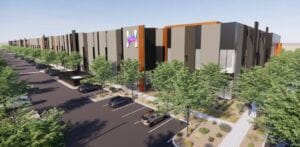It’s not a new concept, but Integrated Project Delivery, or IPD, is finding new life in Valley construction projects.
Put simply, IPD is a type of contract used for construction projects that relies heavily on collaboration between all of the key parties involved. The architect, owner, contractor and any trade partners and engineers that play a key role in the process sign on to the same IPD contract. By doing so, they all share the risk and reward together, so it brings everyone together from the beginning of the project.
“The benefits of IPD is, everybody is working toward the same goal, sharing the same money and so all of the decisions are made as a group instead of the architect drawing something and then we build it,” said Sean Williams, senior project manager for McCarthy Building Companies. “For traditional construction contracts, when there are errors or something goes wrong, there is finger-pointing. While with IPD it’s ‘hey, we have an issue, how do we solve it?’ It’s the most cost efficient, value-add to the owner at the end because we’re all working to save money and add more value.”
McCarthy is seeing great success with the IPD process on many of its healthcare projects, including at Banner Boswell. Williams said that McCarthy has three healthcare projects in the works in the Valley and all three are using the IPD approach or aspects of it.
“It’s a beneficial method for any facility, but it’s just that the healthcare industry is known for being progressive with regard to construction delivery methods ,” Williams said. “Not everyone can just go build a hospital because of its critical and technical nature. So you get more experienced and technically advanced subcontractors, clientele, contractors who work in the space and are willing to collaborate and talk to each other and figure things out. I think eventually, it will bleed into all of the industries because the value is evident, but healthcare is where its starting.”

One of the hallmarks of an IPD project is the early engagement between all of the companies working on the project. Typically, the owner selects an architect and a general contractor. Together, those three entities then begin interviewing partners from vital trades like mechanical, electrical, plumbing, concrete and steel to find the right fit. Selecting companies that fit into the IPD culture is more important than finding the lowest bidder.
“That’s a big change in the industry,” Williams said. “We look at trade partners as value and not just a cost. Just get the right partner, that’s the focus of IPD.”
After the key partners are selected, there is an on boarding process, much like when an employee joins a new company. All of the leaders from the major project entities are put in a room for a couple days of team building and getting to know one another. They also come up with a mission statement and core values to clearly summarize why they are building the project, what it means for the community, what are the project goals and conditions of satisfaction.
This is done to make sure all of the parties have committed to those goals and values and will then go into the field and act accordingly.
“So, we kind of look at it like we’re setting up a company with each project, not just a construction team to go build something,” Williams said.
All of the members of the team co-locate to what they call the “Big Room” for the duration of the project. In the Big Room, the schedule is posted and updated as much as necessary. With all of the parties working out of one room, communication is more open and transparent and the individual companies feel more like one big team.
“This is all about everybody co-locating, staying there, working together so you’re not missing anything and being highly-efficient and effective,” Williams said. “The space is wide open, you see everything in the process. From the outside looking in, it almost looks dysfunctional because people are having conversations that you’re not used to hearing or seeing, but in the end, you get a much better product.”
This early engagement also allows the different trades to discuss problems that might arise and come up with solutions before any work is done.
Williams cites one example, where the architectural plans called for renovating the central corridor that connected several operating rooms. The initial plans called for work that would have taken two months. All of the parties on the project collectively discussed the plan and felt that was an area that didn’t need a full renovation since it was back of house space. Collectively, they revised the plans and went with a simple 2-day renovation.
“We saved a ton of money and a bunch of headaches just because we were able to have the conversation,” Williams said. “With traditional methods, we don’t have that discussion. The architects just make the plans in their silo and then we go and build it.”
Cutting off problems before work begins is just one of the ways that IPD can save time and money on a project. Another way IPD can save money is during the bidding process for materials. With a steel or drywall trade partner already involved in the process well ahead of when they will begin work, those contractors know how the market works and can get the best material/equipment pricing for the project.
With just about every builder in the Valley scraping by on manpower, the collaborative nature of IPD can help them maximize the workforce. With everyone working together to stay on the building, there are fewer instances where a contractor is held up by other work being done.
“We have all of our trade partners to work together to develop a schedule to meet our goals,” Williams said. “Most of the time it becomes shorter in duration because they’re talking with each other, helping each other out and getting their manpower organized how they want it.”




